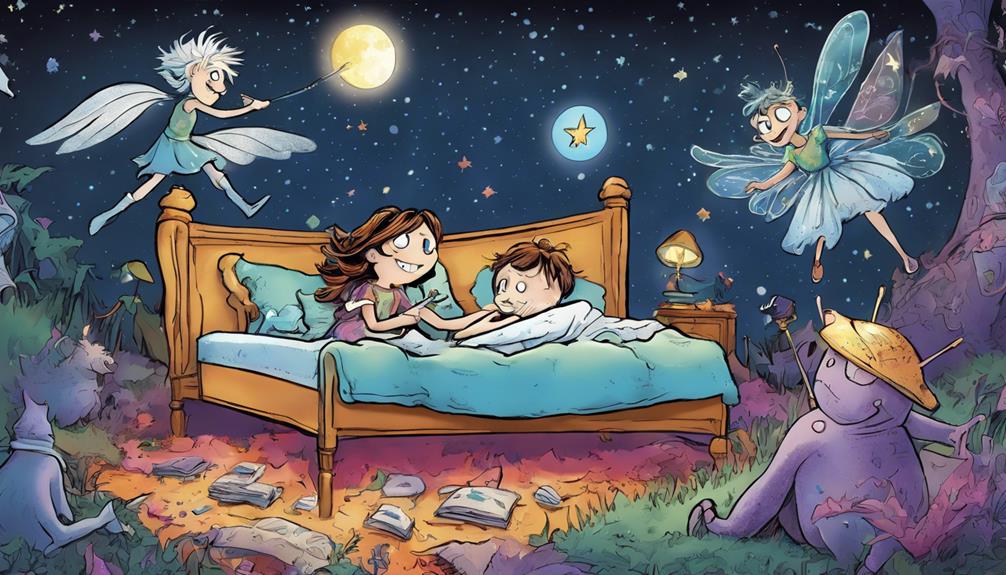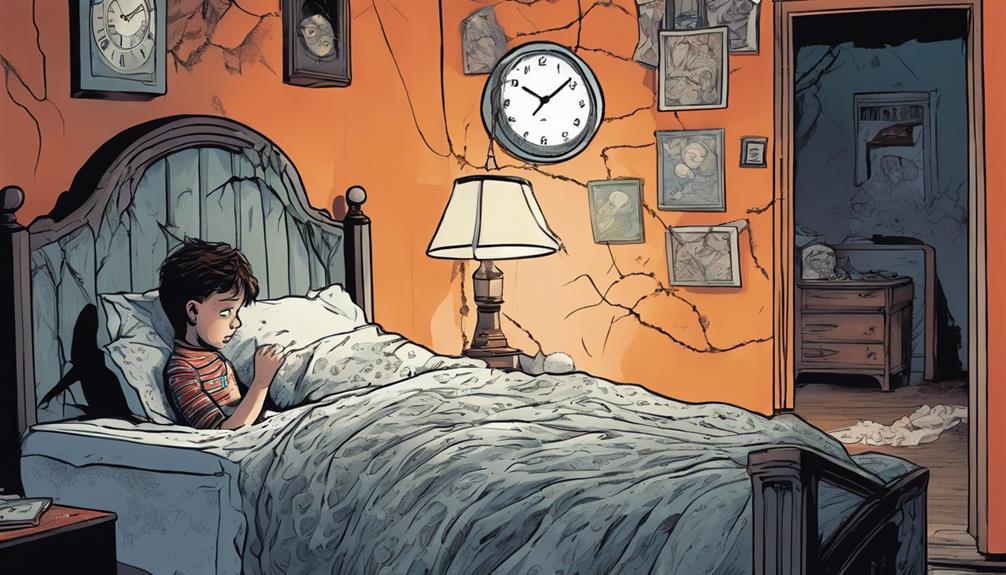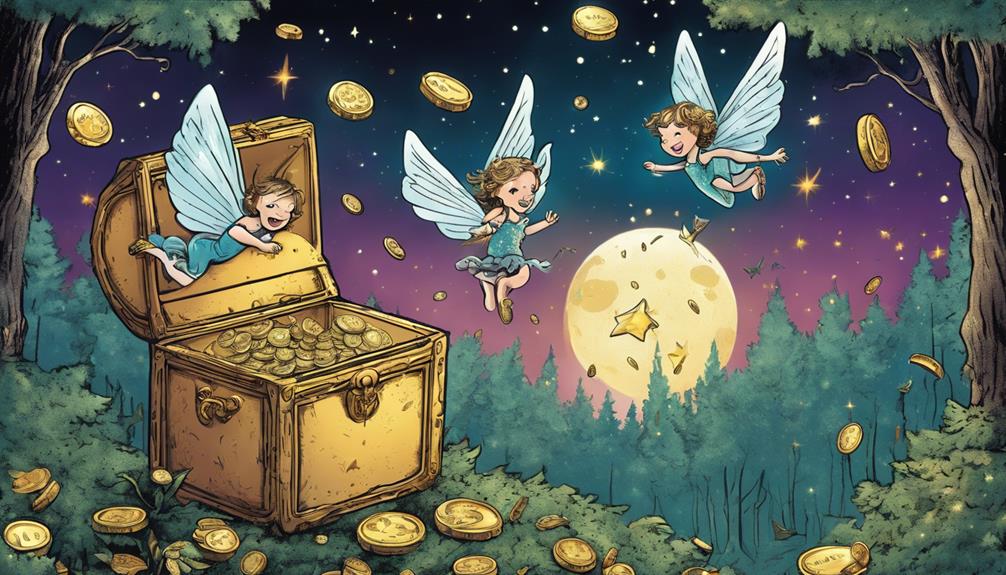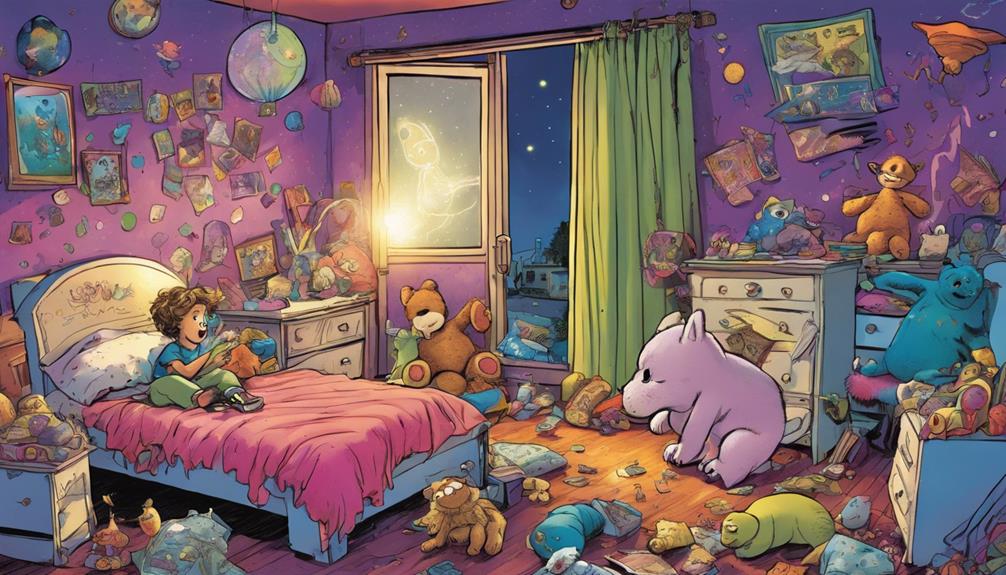The Tooth Fairy's most controversial moments have stirred up quite the conversation. You might be surprised to learn that economic pressures now limit most payments to just $1 to $2, which raises questions about fairness among kids. There's even a gender pay gap, with male fairies reportedly offering more than female ones. Public backlash erupted on social media, reflecting a mix of humor and concern about undermining childhood beliefs. These controversies touch on deeper societal issues, influencing children's understanding of trust and authority. If you find these details intriguing, there's even more to uncover about the Tooth Fairy's magical world.
Key Takeaways
- Post-Covid, parents reported lower Tooth Fairy payouts, with most offering $1 to $2, raising concerns about fairness among children.
- A gender pay gap emerged, with male fairies paying more than female fairies, reflecting broader societal issues of equality.
- Social media backlash followed revelations about the Tooth Fairy, with parents worried about preserving childhood innocence amid economic pressures.
- Discussions arose about the impact of exposing childhood myths on trust in authority figures and children's belief systems.
Seven Sharp's Revelation

In a recent segment, Seven Sharp shattered childhood illusions by revealing the Tooth Fairy's surprising truths, leaving many viewers in New Zealand reeling. Hosts Toni Street and Jeremy Wells tackled the topic with humor, questioning how much the Tooth Fairy should pay in today's post-Covid world.
The lighthearted discussion took a turn when they disclosed that male tooth fairies tend to pay more than their female counterparts, sparking outrage over a perceived gender pay gap among these mythical figures.
Parents flooded social media with shock and criticism, arguing that such a revelation undermines cherished childhood beliefs. Many felt that exposing the truth behind the Tooth Fairy could ruin the magic for their kids, especially during tough times.
This segment not only challenged the longstanding myth but also forced a moral reflection on the fragility of childhood beliefs. Ultimately, the revelation highlighted how easily the enchantment of childhood can be disrupted, igniting a broader conversation on the importance of maintaining these whimsical traditions.
As viewers grapple with this newfound knowledge, they're left questioning how to navigate the delicate balance between truth and fantasy for their children.
Economic Tooth Fairy Trends

Many parents in New Zealand are adjusting their Tooth Fairy payments post-Covid, with most typically offering between $1 and $2 for each lost tooth. This trend reveals a shift in how families view the value of lost teeth.
You might find it amusing that parents are jokingly haggling over these tooth values, as seen in comedic reenactments. It's a sign of the times, reflecting the realities of today's economy.
Interestingly, only 2% of New Zealanders are willing to pay as much as $20 for a single tooth, highlighting how far removed those amounts are from typical payments. The impracticality of handling small change has led some parents to explore alternatives, like using Paywave for easier transactions. You never know, this could become a new norm in Tooth Fairy practices.
Despite the humor surrounding these discussions, there's a serious undertone regarding economic pressures. The last lost tooth mightn't yield the same rewards as the first for many families. As the Tooth Fairy landscape evolves, parents are maneuvering these changes while trying to keep the magic alive for their children.
Gender Pay Gap Among Fairies

You've probably noticed that some kids get more money for their lost teeth from their dads than from their moms.
This disparity raises questions about parental influence and how it shapes children's understanding of fairness.
Let's explore how these unequal tooth payments reflect broader gender dynamics among fairies.
Unequal Tooth Payments Explained
Revealing a surprising gender pay gap among tooth fairies, a recent segment highlighted how male fairies often pay more for lost teeth than their female counterparts. This disparity raises significant questions about fairness and equality in the whimsical world of childhood myths. It turns out that children might've better luck asking their dads for larger tooth payments.
The inconsistency in payments illustrates several broader concerns:
- Financial Inequality: The gap reflects how gender biases can seep into even the most magical aspects of childhood.
- Role Models: Children may inadvertently learn that it's important to treat people differently based on gender, which could shape their future views on equality.
As parents grapple with these insights, it's crucial to address the implications of such disparities early on. The enchanting portrayal of the tooth fairy may need a makeover to align with the principles of fairness and equity.
After all, teaching children about equal treatment starts with acknowledging these disparities, even in the domain of lost teeth.
Parental Influence on Earnings
Parental influence plays a significant role in shaping children's perceptions of earnings, particularly when it comes to the unexpected gender pay gap among tooth fairies.
A recent segment on Seven Sharp revealed that male fairies often pay more for lost teeth than their female counterparts, which can skew kids' expectations. This disparity might lead children to request larger payments from their fathers instead of their mothers.
In New Zealand, 61% of parents typically pay between $1 and $2 per tooth, raising questions about fairness and consistency in tooth fairy payments. The disparity in payments can reflect broader societal issues, making it essential for parents to have discussions with their children about fairness and authority. When children see this gender pay gap, it can instill a sense of confusion about earning potential and gender roles.
Parents expressed outrage over this revelation, feeling it undermines childhood beliefs during tough times. It's important for you, as a parent, to address these issues, ensuring that your children understand the significance of equality and fairness, even in whimsical traditions like the tooth fairy.
Fairies' Gender Dynamics Unveiled
How does the gender pay gap among tooth fairies reflect deeper societal issues of inequality? The recent revelation that male tooth fairies pay more for lost teeth than their female counterparts sheds light on a troubling disparity. This gap suggests that children might receive more generous payouts when asking their fathers compared to their mothers.
This situation isn't just about whimsical figures; it raises serious questions about fairness and equality. Consider these implications:
- Children may develop skewed perceptions of value based on gender dynamics.
- The normalization of unequal pay could shape future attitudes toward trust and roles within families.
Parents have voiced their outrage, concerned about how these practices affect their children's understanding of honesty and trust in the context of cherished childhood myths.
The tooth fairy saga serves as a microcosm of larger economic realities. As you ponder the implications of this whimsical world, remember that even in the domain of fairies, the lessons can reflect the very real challenges of achieving equality in society.
Public Backlash on Social Media

You've probably seen the outrage from parents on social media after the segment about the Tooth Fairy aired.
The mixed reactions highlight a real divide, with some finding humor while others feel their children's beliefs are under threat.
This controversy raises important questions about how such revelations impact childhood trust and imagination.
Outrage Among Parents
Outrage erupted on social media as parents expressed their anger over Seven Sharp's segment that revealed the Tooth Fairy's true nature, claiming it shattered childhood beliefs. Many felt the show had crossed a line, ruining the magic that kids cherish.
The timing of the segment, especially in the post-Covid era, added to the frustration. Parents pointed out that now wasn't the time to undermine childhood myths.
Critics raised several key points:
- Preserving Innocence: Many believe it's essential to maintain childhood illusions, especially during tough times.
- Media Sensitivity: Comparisons were drawn to Jacinda Ardern's efforts to uphold these myths during lockdown, highlighting media's responsibility.
This conversation sparked widespread debate, with some finding humor in the reveal while others felt deeply betrayed. Parents united in their outrage, calling for a more considerate approach to such sensitive topics.
It's clear that the Tooth Fairy's true nature has ignited a discussion far beyond just a myth.
Mixed Viewer Reactions
Many viewers took to social media to share their mixed reactions, with some finding humor in the Tooth Fairy reveal while others expressed deep disappointment over the shattered illusions. Outraged parents voiced concerns about the segment's impact on their children's beliefs, arguing it ruined the magic of childhood at a time when they needed it most. They drew parallels to how former Prime Minister Jacinda Ardern managed childhood myths during the pandemic, emphasizing the importance of maintaining these illusions.
The backlash led to a heated debate about the role of parents in sustaining these traditions and whether skepticism toward authority figures, including parents, should be encouraged. Some viewers defended the segment, arguing that exposing such myths fosters critical thinking, while others felt it undermined the joy and wonder children experience during these formative years.
Additionally, discussions arose around the average tooth fairy payment in New Zealand, with about 61% of the population typically paying between $1 and $2 per tooth. This sparked further conversations about fairness and expectations regarding tooth fairy encounters, leaving many viewers divided over the segment's implications.
Impact on Childhood Beliefs
Following the revealing segment on Seven Sharp, parents took to social media to express their shock and disappointment, fearing that the truth about the Tooth Fairy would diminish their children's sense of wonder. Many felt that this revelation shattered childhood illusions and robbed kids of the joy associated with losing teeth. Critics argued that the timing was particularly insensitive, especially given the challenges families faced during and after the Covid pandemic.
Parents voiced concerns that exposing such myths could damage their children's trust in them and authority figures. This backlash echoed earlier public reactions to similar controversial topics, showing a pattern of anxiety surrounding childhood beliefs.
Key points from this outrage include:
- Trust Issues: Parents worried that revealing the truth behind the Tooth Fairy would lead children to question other myths, eroding trust in their parents.
- Timing Matters: The segment's release during a turbulent time heightened the feeling of betrayal among families.
Ultimately, this incident has sparked a broader conversation about the impact of exposing childhood myths.
Cultural Implications of Beliefs

While the Tooth Fairy myth varies across cultures, it serves as a powerful symbol of childhood growth and the shift to adolescence. When you consider how children lose their baby teeth, this rite of passage becomes a shared experience that transcends borders. However, the figure of the Tooth Fairy isn't universal; some cultures embrace alternatives like the Tooth Mouse, which demonstrates the unique ways societies celebrate this milestone.
In New Zealand, the revelation about the Tooth Fairy's true nature sparked essential conversations about trust and honesty. You realize how fragile childhood beliefs can be, especially in today's fast-paced world. Economic factors also play a role—most New Zealanders pay between $1 and $2 per tooth, shaping children's expectations about value and money.
Additionally, the portrayal of Tooth Fairies, both male and female, brings up discussions about gender equality and fairness. These narratives, while whimsical, reflect deeper societal issues that resonate with both children and adults. By examining these cultural implications, you gain insight into how a simple myth can influence perceptions, values, and even social justice conversations in modern society.
Jack and Daisy's Tooth Adventure

In 'Jack and Daisy's Tooth Adventure,' Daisy cleverly crafts a fake tooth out of paper and flour when her lost tooth goes missing, setting off a whimsical journey with her brother Jack. As they place the fake tooth under her pillow, they unwittingly attract the attention of two fairies, Wally and Jim, who soon uncover the ruse. This twist leads them on an unexpected adventure filled with enchantment and mischief.
Throughout the story, you'll notice a few key elements that make their journey memorable:
- Creativity: Daisy's ability to improvise shows the power of imagination.
- Sibling Bond: Jack's support highlights the importance of family in overcoming challenges.
The narrative beautifully weaves together these themes, all while Lillian Hoban's illustrations bring the whimsical atmosphere to life. The portrayal of Wally and Jim as elderly men adds a unique twist to the traditional fairy tale, keeping readers engaged and enchanted.
This adventure not only entertains but also sparks curiosity about the consequences of deception in a lighthearted way.
Themes of Responsibility and Trust

How do children's beliefs in the Tooth Fairy shape their understanding of trust and responsibility in relationships with their parents?
When kids believe in the Tooth Fairy, they often develop a sense of trust in their parents. However, this trust can turn to feelings of betrayal when they eventually learn the truth. The segment on Seven Sharp illustrates how essential parental honesty is in nurturing that trust.
Moreover, parents' decisions about tooth payments can complicate matters. The comedic reenactment of haggling over prices raises questions about responsibility. Children might perceive these financial exchanges as lessons about honesty, fairness, and even inequality when they hear about a gender pay gap among Tooth Fairies.
Daisy's creation of a fake tooth serves as a cautionary tale about deception. It shows that cheating can lead to unforeseen challenges and highlights the need for accountability.
The outrage from parents after the Tooth Fairy revelation underscores the delicate balance between fostering imagination and maintaining trust.
Ultimately, these themes of responsibility and trust are significant in shaping how children navigate their relationships with parents and the broader world.
Character Dynamics in the Story

The interplay between characters like Daisy and Jack illustrates the complexities of family dynamics as they navigate trust and deception in their Tooth Fairy adventure.
Daisy's creativity shines through when she crafts a fake tooth, showcasing her impulsive yet resourceful nature. Meanwhile, Jack's supportive role highlights the strength of their sibling bond as he helps her execute this plan.
As you explore their relationship, consider how these dynamics unfold:
- Cooperation: Jack's willingness to assist Daisy emphasizes the importance of teamwork in overcoming challenges.
- Trust: Their shared secret creates an underlying tension, testing their loyalty to each other.
Moreover, the character of Puss adds an element of danger, representing the unforeseen consequences of Daisy's decision to cheat the Tooth Fairy.
Through these character interactions, you see how family relationships can both support and challenge the individuals involved, ultimately shaping their journey in this whimsical yet complex narrative.
The Tooth Fairy's Cultural Significance

Tooth Fairy traditions highlight the joy and imagination that come with childhood, marking a significant rite of passage as children shift from innocence to maturity. When your child loses a baby tooth, it's more than just a milestone; it symbolizes their growth and the gradual evolution to adulthood.
Across cultures, the customs surrounding the Tooth Fairy vary. While some societies celebrate with unique tooth disposal rituals, others focus on the rewards exchanged for lost teeth. This diversity enriches the myth, showing how families worldwide engage with this tradition in their own special ways.
The Tooth Fairy myth fosters creativity, encouraging children to explore the fantastical aspects of their world. As parents, you have the chance to craft magical narratives that transform the mundane experience of losing teeth into something extraordinary. This escapism not only brings joy but also strengthens family bonds.
Moreover, maintaining the Tooth Fairy myth reflects our collective desire to preserve childhood innocence. In a world that often emphasizes adult responsibilities, this enchanting tradition allows children to experience wonder and excitement, helping them navigate the complexities of growing up.
Frequently Asked Questions
What Is the Dark Story Behind the Tooth Fairy?
The Tooth Fairy's origins aren't all magic and fun. You'll find darker folklore traditions where teeth were buried or burned to protect against evil spirits, revealing a more serious cultural significance behind this whimsical figure.
How to Explain the Tooth Fairy Isn't Real?
When explaining the Tooth Fairy isn't real, gently share that it's a fun story parents tell. Emphasize the joy and imagination it brings, while assuring them it's okay to let go of childhood fantasies.
What Is the Myth of the Tooth Fairy?
The Tooth Fairy's tale tantalizes! You place your lost tooth under your pillow, dreaming of delightful surprises. This whimsical tradition transforms the mundane into magic, sparking imagination and creating cherished childhood memories of wonder and excitement.
Is There Any Evidence of the Tooth Fairy?
There isn't any concrete evidence supporting the Tooth Fairy's existence. It's a myth rooted in cultural traditions surrounding tooth disposal, created to make losing teeth a magical experience for children, rather than a factual reality.
What Controversial Moments Has the Tooth Fairy Faced in Her Career?
The tooth fairy’s career has not been without controversy. One of the most infamous moments was the tooth fairy’s rival takeover attempt, when a competing mythical creature tried to steal her job. Despite the turmoil, the tooth fairy has remained resilient and continues to bring joy to children worldwide. After the tooth fairy incident, there was a lot of speculation and confusion among children and parents alike. Many were wondering if the tooth fairy was going to be replaced or if her duties would be taken over by someone else. However, the tooth fairy quickly issued a statement with a tooth fairy incident explanation, reassuring everyone that she was still dedicated to her role and that the attempted takeover would not affect her ability to collect teeth and leave rewards. This incident only served to strengthen her resolve and commitment to her important job. Since the tooth fairy attack incident, the tooth fairy has taken extra precautions to ensure that her job is secure. She has increased security measures and has been working on building better relationships with children and their families to regain their trust. Despite the setback, the tooth fairy’s determination and resilience have only grown stronger, and she continues to carry out her duties with the same love and care as before.
Conclusion
In the whimsical world of the Tooth Fairy, controversy and curiosity collide.
You've explored the economic shifts, gender gaps, and social stirrings surrounding this beloved figure.
As you reflect on Jack and Daisy's daring dental adventure, remember the deeper themes of trust and responsibility entwined within their tale.
The Tooth Fairy's cultural significance continues to shape our childhood dreams, sparking spirited discussions and delightful debates.
So, what's your take on the Tooth Fairy's turbulent truths?









